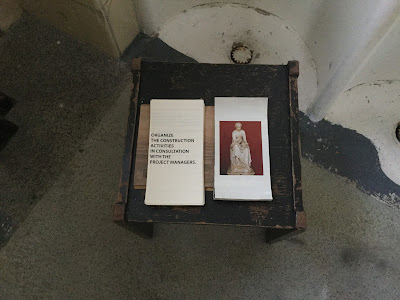Calliope
or how
a public square can fit into a public urinal
Omonoia
Square is the oldest and
most central square of Athens. Former ‘Othon Square’, it took the name Omonoia
(Concord) in 1862, after the overthrow of the king.
Omonoia Square is an exemplary case of interference with public space and its social aspects. In a collective conscience Omonoia
Square has been recorded as an urban landscape under construction, as a no
man's land. What is worth noticing in the constant temporalities[1]
of the square is the succession of local and international paradigms as issues of an ongoing discourse on public space.
of the square is the succession of local and international paradigms as issues of an ongoing discourse on public space.
In 1934,
the look of the square comprised eight big sculptural constructions, which were
placed on it in order to cover the holes of the ventilation system of the
underground station. Each construction featured the statue of a sitting muse.
These were called ‘the
muses of Omonoia’. Even
though according to the ancient tradition the muses were nine, only eight of
them were placed on the square for reasons of symmetry. Calliope, the ninth muse, was placed underground,
just next to the public urinals. Since then the name Calliope has been
identified in collective conscience with the toilet, a metonymy very commonly
used in the slang of the Greek army. After a few years the muses were withdrawn
and Omonoia Square underwent a series of aesthetic and architectural
modifications, which have made it a typical case of unfortunate urban planning
in public space. The whereabouts of the statue of Calliope are today unknown.
Campus
Novel call on Calliope as an allegoric
persona
non grata, in order
to refer to issues of collective memory and the role of art and architecture in
the formation of national identity and modern history. Furthermore, we are
interested in investigating on the one hand the forms of collective repression
of the present towards social, ethical and aesthetic issues and on the other
hand the pressure and the trauma of the dictates for cultural supremacy. The symbolic location of Calliope in a former public urinal is suggested as a tracing of an urban
legend, but mostly as a means of mending the relationship between the
archeological past and the current concept of urban experience. The approach is
an inventive interpretation of reality. The term "reality" is used in
the lacanian way of seeking the hidden meaning of things and places as part of
everyday life, in the same way that A. Badiou distinguishes it from a formal
incident[2].
Calliope is a two-level site-specific installation based on the one hand on archival
material and on the other on an invention of the imaginary persona of Calliope.
[1] Saskia Sassen, “Juxtaposed Temporalities: Producing a new Zone”, Anytime
Magazine, New York 1999
[2] Alain Badiou, Being and Event, New
York: Continuum, 2005









